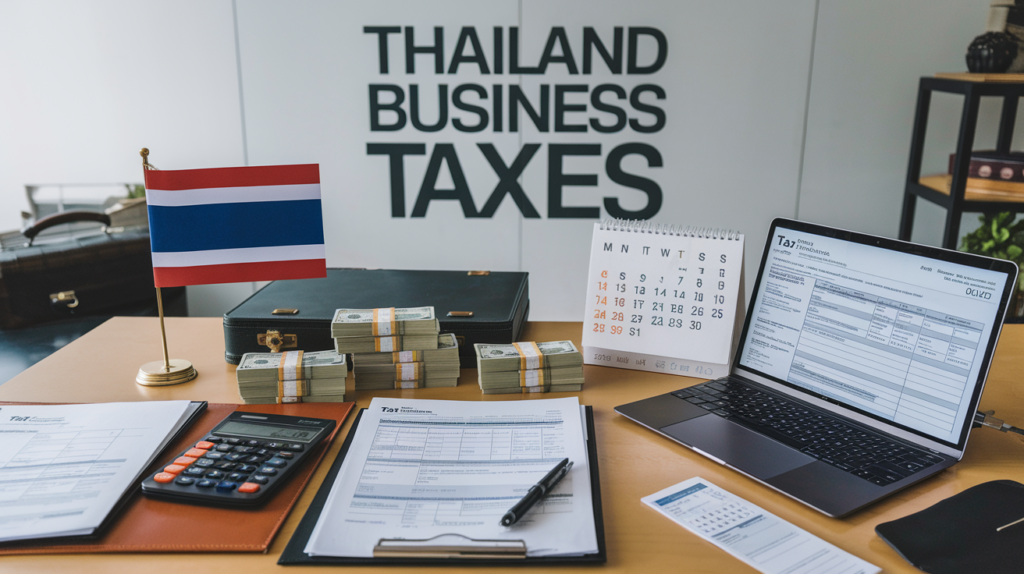Are you an entrepreneur looking to expand your business into Thailand? 🌴 While the Land of Smiles offers exciting opportunities, navigating its tax landscape can be a daunting challenge. From corporate income tax to value-added tax (VAT) regulations, understanding Thailand’s complex tax system is crucial for your business success.
But don’t let tax worries hold you back! In this comprehensive guide, we’ll demystify Thailand’s business taxes and compliance requirements. We’ll explore everything from withholding tax obligations to employment-related taxes, ensuring you’re well-equipped to make informed decisions. Plus, we’ll delve into recent tax changes and future outlooks, keeping you ahead of the curve in this dynamic business environment.
Join us as we unravel the intricacies of Thailand’s tax system, covering corporate income tax, VAT regulations, double taxation agreements, and much more. Whether you’re a seasoned business owner or a startup entrepreneur, this guide will provide you with the essential knowledge to navigate Thailand’s tax landscape with confidence. Let’s dive in and unlock the secrets to tax compliance in the heart of Southeast Asia! 🔑💼
Overview of Thailand’s Tax System

A. Key tax types for businesses
Thailand’s tax system comprises several key types of taxes that businesses must navigate:
- Corporate Income Tax (CIT)
- Value Added Tax (VAT)
- Withholding Tax
- Personal Income Tax (for employees)
- Specific Business Tax (SBT)
- Stamp Duty
Each of these taxes serves a specific purpose and applies to different aspects of business operations. Understanding these tax types is crucial for compliance and effective financial planning.
| Tax Type | Description | Applicability |
|---|---|---|
| CIT | Tax on company profits | All registered companies |
| VAT | Tax on goods and services | Businesses with annual turnover > 1.8 million THB |
| Withholding Tax | Tax deducted at source | Various transactions and payments |
| Personal Income Tax | Tax on individual earnings | Employees and business owners |
| SBT | Tax on specific business activities | Banks, real estate, insurance |
| Stamp Duty | Tax on certain documents and transactions | Various legal and financial documents |
B. Tax rates and thresholds
Tax rates in Thailand vary depending on the type of tax and the nature of the business. Here are some key rates and thresholds:
- Corporate Income Tax: Standard rate of 20% for most companies
- VAT: Standard rate of 7% (temporarily reduced from 10%)
- Withholding Tax: Ranges from 1% to 15% depending on the transaction
- Personal Income Tax: Progressive rates from 0% to 35%
- Specific Business Tax: Rates vary from 0.1% to 3% depending on the business activity
It’s important to note that these rates may be subject to change, and certain exemptions or reductions may apply based on specific criteria or government incentives.
C. Fiscal year and tax filing deadlines
The standard fiscal year in Thailand runs from January 1 to December 31. However, companies can choose a different 12-month period as their fiscal year with approval from the Revenue Department. Key tax filing deadlines include:
-
Corporate Income Tax:
- Half-year return: Within 2 months after the first 6 months
- Annual return: Within 150 days after the end of the accounting period
-
VAT:
- Monthly filing: By the 15th of the following month
-
Withholding Tax:
- Monthly filing: Within 7 days of the following month for most cases
-
Personal Income Tax:
- Annual filing: By March 31 of the following year
Adhering to these deadlines is crucial to avoid penalties and maintain good standing with the Thai tax authorities. Now that we’ve covered the basics of Thailand’s tax system, let’s delve into the specifics of Corporate Income Tax in the next section.
Corporate Income Tax in Thailand

A. Tax rates for different business types
In Thailand, corporate income tax rates vary depending on the type and size of the business. Here’s a breakdown of the main tax rates:
| Business Type | Tax Rate |
|---|---|
| Standard companies | 20% |
| Small and medium-sized enterprises (SMEs) | 15-20% |
| Companies listed on the Stock Exchange of Thailand (SET) | 20% |
| Regional Operating Headquarters (ROH) | 10% |
| International Business Centers (IBC) | 8%, 5%, or 3% |
SMEs with paid-up capital not exceeding 5 million baht enjoy a graduated tax rate structure, paying 15% on the first 3 million baht of net profit and 20% on any amount exceeding that.
B. Calculating taxable income
Taxable income in Thailand is determined by:
- Gross income
- Allowable deductions
- Tax exemptions
Net profit is calculated by subtracting allowable deductions from gross income. It’s crucial to maintain accurate financial records and understand which expenses are deductible to ensure correct tax calculations.
C. Deductible expenses
Thai tax law allows for various deductible expenses, including:
- Operating expenses
- Depreciation of assets
- Bad debts
- Contributions to approved charities (up to 2% of net profit)
- Research and development costs
However, certain expenses have limitations or are non-deductible, such as personal expenses, fines, and penalties.
D. Tax incentives and exemptions
Thailand offers several tax incentives to promote investment and economic growth:
- Board of Investment (BOI) privileges
- Special Economic Zones (SEZ) benefits
- Eastern Economic Corridor (EEC) incentives
These can include tax holidays, reduced tax rates, and exemptions on import duties for machinery and raw materials. Businesses should carefully evaluate their eligibility for these incentives to optimize their tax position.
Value Added Tax (VAT) Regulations

VAT registration requirements
In Thailand, businesses with annual turnover exceeding 1.8 million baht are required to register for VAT. However, certain businesses must register regardless of their turnover:
- Importers
- Exporters
- Businesses providing specific services (e.g., hotels, restaurants)
Registration process:
- Submit application to Revenue Department
- Provide necessary documentation
- Obtain VAT certificate
| Business Type | Registration Threshold |
|---|---|
| General | 1.8 million baht/year |
| Importers | No threshold |
| Exporters | No threshold |
| Specific Services | No threshold |
VAT rates and exempt goods/services
Thailand’s standard VAT rate is 7%, applied to most goods and services. Some items are exempt or zero-rated:
- Exempt: Unprocessed agricultural products, educational services, domestic transportation
- Zero-rated: Exported goods and services
Input and output VAT
- Input VAT: Tax paid on purchases
- Output VAT: Tax collected on sales
Businesses can claim input VAT credits against output VAT, paying only the difference. Proper documentation is crucial for claiming these credits.
VAT filing and payment procedures
VAT-registered businesses must:
- File monthly VAT returns (Form PP30)
- Submit by the 15th of the following month
- Pay any VAT due simultaneously with filing
Electronic filing is encouraged for efficiency and accuracy. Late filing or payment incurs penalties and interest charges.
Now that we’ve covered VAT regulations, let’s explore withholding tax obligations in Thailand.
Withholding Tax Obligations

Types of income subject to withholding tax
Withholding tax in Thailand applies to various types of income, including:
- Salaries and wages
- Dividends
- Interest
- Royalties
- Rent and lease payments
- Professional fees
- Service fees
- Capital gains
Withholding tax rates
Withholding tax rates in Thailand vary depending on the type of income and the status of the recipient. Here’s a table summarizing the most common withholding tax rates:
| Income Type | Resident Rate | Non-Resident Rate |
|---|---|---|
| Dividends | 10% | 10% |
| Interest | 15% | 15% |
| Royalties | 3-15% | 15% |
| Services | 3-5% | 5-15% |
| Rent | 5% | 15% |
Reporting and remittance requirements
To comply with Thai withholding tax obligations, payers must:
- Deduct the appropriate withholding tax amount
- Issue a withholding tax certificate to the recipient
- File monthly withholding tax returns (Form PND 3 or PND 53)
- Remit the withheld tax to the Revenue Department
Key points to remember:
- Monthly returns and payments are due by the 7th of the following month
- Annual reconciliation is required (Form PND 3A or PND 53A)
- Failure to comply may result in penalties and interest charges
Now that we’ve covered withholding tax obligations, let’s move on to employment-related taxes and social security contributions in Thailand.
Employment-related Taxes and Social Security

A. Personal income tax for employees
Personal income tax in Thailand follows a progressive rate system, with rates ranging from 0% to 35%. Here’s a breakdown of the tax brackets:
| Taxable Income (THB) | Tax Rate |
|---|---|
| 0 – 150,000 | 0% |
| 150,001 – 300,000 | 5% |
| 300,001 – 500,000 | 10% |
| 500,001 – 750,000 | 15% |
| 750,001 – 1,000,000 | 20% |
| 1,000,001 – 2,000,000 | 25% |
| 2,000,001 – 5,000,000 | 30% |
| Over 5,000,000 | 35% |
Employers are responsible for withholding income tax from their employees’ salaries and remitting it to the Revenue Department.
B. Social security contributions
Both employers and employees are required to contribute to Thailand’s social security system. The contribution rates are as follows:
- Employer: 5% of the employee’s salary (capped at THB 750 per month)
- Employee: 5% of their salary (capped at THB 750 per month)
These contributions cover various benefits, including:
- Sickness and medical care
- Maternity benefits
- Disability benefits
- Death benefits
- Child allowance
- Old-age pension
- Unemployment insurance
C. Provident fund regulations
Provident funds are voluntary savings schemes that provide additional retirement benefits for employees. Key points include:
- Employers can establish provident funds for their employees
- Employee contributions are typically 2-15% of their salary
- Employers must match employee contributions at a rate of at least 2-3%
- Contributions are tax-deductible for both employers and employees
- Funds are managed by licensed asset management companies
Now that we’ve covered employment-related taxes and social security, let’s examine the double taxation agreements Thailand has in place with other countries.
Double Taxation Agreements

A. Countries with DTAs with Thailand
Thailand has established Double Taxation Agreements (DTAs) with numerous countries to promote international trade and investment. As of 2023, Thailand has DTAs in force with over 60 countries, including major economic partners such as:
| Region | Countries |
|---|---|
| Asia | China, Japan, South Korea, Singapore, Malaysia, India |
| Europe | United Kingdom, Germany, France, Netherlands, Switzerland |
| North America | United States, Canada |
| Oceania | Australia, New Zealand |
B. Benefits of DTAs for foreign businesses
DTAs offer several advantages for foreign businesses operating in Thailand:
- Prevention of double taxation
- Reduced withholding tax rates
- Clarity on tax residency status
- Protection against discriminatory taxation
- Enhanced dispute resolution mechanisms
These benefits not only minimize tax burdens but also provide a more predictable and stable tax environment for international businesses.
C. Applying for DTA benefits
To take advantage of DTA benefits, foreign businesses must follow a specific process:
- Determine eligibility based on the relevant DTA
- Obtain a tax residency certificate from the home country
- Submit the certificate and required forms to Thai tax authorities
- Comply with specific documentation and reporting requirements
It’s crucial to note that DTA benefits are not automatically applied. Businesses must proactively claim these benefits and maintain proper documentation to support their claims.
Now that we’ve covered the essentials of Double Taxation Agreements, let’s explore the crucial aspects of tax compliance and reporting in Thailand.
Tax Compliance and Reporting

A. Annual tax return filing
Annual tax return filing is a crucial aspect of tax compliance in Thailand. Companies must submit their Corporate Income Tax (CIT) returns within 150 days from the end of their accounting period. It’s essential to understand the key components of this process:
- Form PND 50: The primary form for annual CIT returns
- Financial statements: Must be audited and submitted along with the return
- Transfer pricing disclosure form: Required for companies with related party transactions
- Supporting documents: Receipts, invoices, and other relevant records
| Deadline | Form | Description |
|---|---|---|
| 150 days from year-end | PND 50 | Annual CIT return |
| 150 days from year-end | Audited financial statements | Company’s financial report |
| With PND 50 | Transfer pricing disclosure | For related party transactions |
B. Monthly and semi-annual tax payments
In addition to annual returns, businesses in Thailand must comply with regular tax payment schedules:
- Monthly withholding tax: Due by the 7th of the following month
- Monthly VAT: Due by the 15th of the following month
- Semi-annual CIT: Paid twice a year based on estimated annual profits
C. Record-keeping requirements
Proper record-keeping is crucial for tax compliance in Thailand. Companies must:
- Maintain accounting records in Thai language
- Keep records for at least 5 years
- Use Thai Baht for all financial transactions
- Implement a reliable accounting system
D. Penalties for non-compliance
Non-compliance with Thai tax regulations can result in severe penalties:
- Late filing: Fines up to 200% of the tax due
- Inaccurate returns: Penalties of up to 100% of the underpaid tax
- Tax evasion: Criminal charges and imprisonment in severe cases
Businesses must prioritize tax compliance to avoid these penalties and maintain good standing with Thai tax authorities.
Recent Tax Changes and Future Outlook

Key tax reforms in recent years
Thailand has implemented several significant tax reforms in recent years to modernize its tax system and improve the business environment. Some notable changes include:
- Introduction of e-filing and e-payment systems
- Reduction of corporate income tax rate from 30% to 20%
- Implementation of transfer pricing regulations
- Expansion of the VAT refund system for tourists
| Reform | Year Implemented | Impact |
|---|---|---|
| E-filing system | 2015 | Simplified tax reporting process |
| Corporate tax rate reduction | 2013 | Increased competitiveness for businesses |
| Transfer pricing rules | 2019 | Aligned with OECD guidelines |
| Expanded VAT refund | 2018 | Boosted tourism spending |
Proposed changes to the tax system
The Thai government is considering further reforms to enhance revenue collection and promote economic growth:
- Digital services tax on foreign e-commerce companies
- Revision of personal income tax brackets
- Introduction of environmental taxes
- Streamlining of tax incentives for targeted industries
Impact on businesses operating in Thailand
These recent and proposed changes have significant implications for businesses:
- Improved ease of doing business through digital tax systems
- Potential cost savings from lower corporate tax rates
- Increased compliance requirements, especially for multinational companies
- New opportunities in environmentally friendly industries
Businesses should stay informed about these developments and adjust their strategies accordingly to capitalize on opportunities and mitigate potential risks in Thailand’s evolving tax landscape.

Navigating Thailand’s tax system requires a comprehensive understanding of various components, from corporate income tax and VAT to withholding tax and employment-related obligations. Businesses operating in Thailand must stay informed about these tax requirements, comply with reporting deadlines, and leverage double taxation agreements when applicable. By doing so, they can ensure smooth operations and avoid potential penalties.
As Thailand continues to evolve its tax landscape, staying up-to-date with recent changes and future developments is crucial. By partnering with local tax experts and maintaining diligent record-keeping practices, businesses can confidently navigate the complexities of Thai taxation. Ultimately, a proactive approach to tax compliance not only safeguards your business but also contributes to Thailand’s economic growth and stability.

